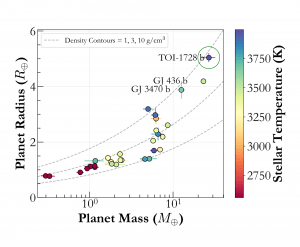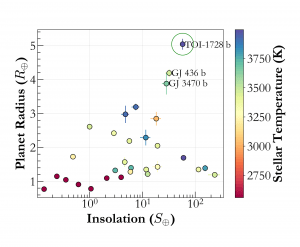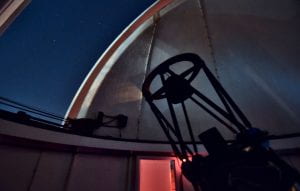The Discovery
A component of HPF’s on-sky time is used to follow up on potential planets discovered by NASA’s Transiting Exoplanet Survey Satellite (TESS), launched in 2018. TESS is nominally a 2-year mission designed to conduct an all-sky survey to find transiting exoplanets. It spends one year in each celestial hemisphere, which is divided into 12-13 sectors that TESS monitors for 27 days each. You can see more about TESS and its survey strategy in the video below.
One of the planet candidates discovered by TESS in its second year was TOI-1728b from Sector 20. Orbiting an “early M” star (it has a surface temperature of around 4,000 Kelvin; the Sun’s surface temperature is approximately 6,000 Kelvin), the depth of the transit represented a planet larger than Neptune, with a radius 5 times larger than Earth’s. The planet completes an orbit around its star every 3.5 days.
As we have recently discussed on this blog, transforming a planet candidate into a full-fledged, well-characterized exoplanet takes a lot of follow-up observing from the ground. Here, we’ll show you how we confirmed the discovery of TOI-1728b, and measured its mass with HPF.
Transit Follow up
We followed up this object with the 0.4 m PlaneWave telescope located on the roof of Davey Lab at University Park, Penn State in order to catch more transits of the planet.
This transit follow up helped us to confirm the TESS transit, and obtain an independent measurement unaffected by spurious background stars which can affect the TESS detection due to its larger pixel size. To insulate us from potential bad weather (as can often happen at State College), we also followed up on this target from the 17″ Perkin telescope at Hobart and William Smith Colleges in Geneva, NY, to obtain a similar result. Shown below is what the transit shape looks like from the three different instruments –
HPF follow up
As we worked to catch more transits, we also started observing this target as part of our M dwarf TESS follow up program with HPF, to measure the planet’s mass via the star’s Doppler shifts. For a transiting planet, it is especially useful to use Doppler measurements to estimate its mass, as that information can be combined with the radius (which we got from the transit) to estimate the planet’s density. The density is the first hint at a planet’s bulk composition: that is, is it rocky like Earth, or dominated by a gaseous atmosphere? As an example, consider two planets of the Solar system. Earth, which is composed mostly of rock and metal, has a bulk density of about 5.5 grams per cubic centimeter. The gas giant Jupiter, on the other hand, has a bulk density of just 1.3 grams per cubic centimeter! To compare the densities of exoplanets, astronomers typically use the mass-radius diagram, which allows us to examine how planets’ compositions vary with size, temperature, and other physical properties.
TOI-1728b falls in a region of Mass-Radius (M-R) space for M dwarf planets that is occupied by two other Neptune-sized planets: GJ 3470b and GJ 436b. Using our HPF Doppler measurements, we measure the mass of the planet to be around 26 Earth masses, thereby being more massive than Neptune, which is only 17 times as massive as Earth.

Mass-Radius plane for M dwarf planets showing TOI-1728b. TOI-1728b is both more massive and larger than the other two Neptunes orbiting M dwarfs (GJ 3470b and GJ 436b).
Searching for signs of atmospheric escape
GJ 3470b was studied by an HPF team led by Joe Ninan, where we detected helium escaping from the planet’s atmosphere. Given the similarities between these exo-Neptunes, we decided to search for signs of atmospheric escape in TOI-1728b using the same technique.
We did not find any evidence for helium escape in the planetary atmosphere, and placed an upper limit of 1.1% for helium escape measured in the near-infrared atomic absorption line. For comparison, our detection in GJ 3470b was at 1.5%. The lack of detection is interesting for the following reasons: as can be seen in the comparison chart below, TOI-1728b receives slightly more energy (insolation) from its star than the other two comparable planets, and at the same time, has a lower bulk density. Both of these factors favour atmospheric escape, potentially making the detection easier. This lack of detection could be due to differences in the composition of the planet, as well as a relative lack of high-energy radiation from the star compared to GJ 3470b.

Comparing the planetary radius and insolation for M dwarf planets. TOI-1728b orbits an earlier type (hotter) host star, and therefore receives more insolation than the other sub-Jovian (smaller than Jupiter) M dwarf planets.
Conversely, TOI-1728b could be similar to GJ 436b, where the CARMENES team also report no detection of helium atmospheric escape using similar methods. GJ 436b does have a detection of hydrogen escape as seen from an ultraviolet absorption feature with the Hubble Space Telescope (HST). Therefore, TOI-1728b represents a good opportunity for further follow up observations with HST to potentially detect hydrogen atmospheric escape. If HST also shows no hydrogen escape, that information would be very informative for understanding how stars dislodge atoms from their planets’ atmospheres.
Potential for transmission spectroscopy
While our HPF observations immediately place constraints on any gas escaping from TOI-1728b, they also set the stage for future measurements of the planet’s real atmosphere with HST and the upcoming NASA flagship James Webb Space Telescope (JWST). TOI-1728 is bright enough to facilitate detailed observations with space telescopes, and now our HPF mass measurement indicates the planet’s density is low enough that plenty of starlight should be filtering through its atmosphere to create a detectable signal. Hopefully, we are just starting to learn what this exciting planet is made of!



 RSS - Posts
RSS - Posts